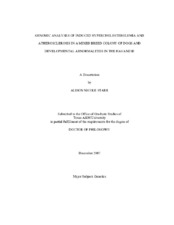| dc.description.abstract | The domestic dog, Canis lupus familiaris, is a unique model system for the dissection of hereditary diseases. Selective breeding practices have created more than 300 distinct breeds of dogs, born from a desire to create specific physical and behavioral characteristics. Breeds represent closed breeding populations and the extensive records maintained for members of each breed (e.g., multi-generational pedigrees, veterinary medical records) present an incredible tool for genetic research. Two closed populations were used in the work presented here: a colony of mixed-breed dogs segregating resistance and sensitivity to cholesterol feeding, and a purebred pet population of Havanese experiencing a high frequency of developmental abnormalities. Estimates of heritability were calculated for each disease to evaluate the degree of phenotypic variation attributable to genetics among dogs in the populations used. A heritability of 0.55 (± 0.16) was identified for cholesterol resistance and sensitivity in the mixed-breed colony. The small sample size prevented the use of complex segregation analyses to examine mode of transmission. A heritability of 0.36 (± 0.26) was calculated for the composite phenotype in the Havanese, encompassing the spectrum of abnormalities in the breed. Polygenic inheritance was identified for the composite phenotype, but the action of a major gene was identified by complex segregation analyses in the Havanese. Complex diseases preclude the use of a candidate gene approach, owing to the multitude of genes involved in the disease process. Whole genome screens provide a practical approach to the identification of chromosomal region(s) associated with a disease phenotype by narrowing the search for candidate gene(s). The Minimal Screening Set – 2 (MSS-2) was used in the present studies to evaluate the segregation of microsatellite markers in pedigrees for both the mixed-breed colony and the Havanese. No significant LOD scores were identified, though suggestive LOD scores were obtained in both analyses. A canine-specific oligonucleotide microarray was used to create gene expression profiles for developmental abnormalities in the Havanese and for cholesterol sensitivity in the mixed-breed colony dogs. Distinct expression profiles were generated for each group, and several genes of interest were identified as being both differentially expressed (>±2-fold change) and statistically significant (p-value<0.05). | en |


